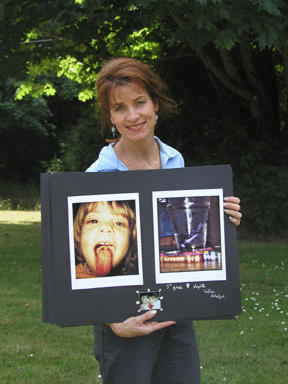Jennifer Callan framed Blakely School third-graders.
When teacher Erin Sheehan’s lucky class encountered the talented mom, they got a crash course in photography, turning out work good enough to frame and hang on a gallery wall.
“They look like a professional group of avant-garde photographs,” Callan said. “It’s a really fascinating look at life through these kids’ eyes, so far ahead of their verbal capacity.”
Callan volunteered to be art docent in Sheehan’s class. The job might have entailed some “art appreciation” and a few craft projects, but Callan – whose credits include producer, videographer and editor at NBC affiliate WBZ in Boston, and director of photography for Seattle’s “Bill Nye the Science Guy” – thought the kids could learn more doing a single intense, six-month project.
She asked parents to invest in a throwaway camera, and to pay for printing the results.
Each child was challenged to look through the lens in unique ways.
“I assigned the kids some tough things to shoot,” Callan said. “‘Show me a positive emotion, show me a negative emotion, show me a person/place that means something to you.’”
The students were told to take pictures that portrayed feeling; Callan asked for “tantrums, anger, laughter, wonder, peace and loneliness.”
She stressed point-of-view to the students, demanding that they find unusual vantage points.
“I told them to shoot from under their beds or down from their tree house, through windows,” Callan said, “I told them I didn’t want anything boring.”
Students came back with photographs of gerbils poking from a coat pocket; a ragged line of bathers emerging from the water; siblings caught mid- tantrum; a man seated at a table, head in his hands in an unguarded moment of weariness or despair.
Click it and clip it
Next, the children learned that there was more to making a photograph than pushing the button.
Callan worked with each child individually, helping the young artists select an image, and then walking them through the crucial process of deciding how to crop the chosen photograph.
“I would ask them, ‘what’s your picture about? Where’s your focus?’ Callan said.
Through a step-by-step process of refinement, Garrett Gangmark-Strickland’s initial photograph of a yawning cat lying on a sofa zeroes in on the heart of the picture, the crucial element – the open mouth.
Gangmark-Strickland also shifted the image 90 degrees so that the reclining feline sits upright, shifting the lassitude of yawn to the threat of a closeup snarl with lots of sharp teeth.
When all the images found their final form, Callan printed two 8×10 photos for each child. The works were mounted on black display boards and hung on Sheehan’s class walls.
But Callan decided the process of approaching art in a professional manner needed one more step.
To make the point that the students’ work were polished, Callan turned the parents’ June 14 viewing of the photos into a real opening, asking that the youngsters dress for the occasion and serving cider in plastic champagne glasses.
“I guess the champagne glasses weren’t very politically correct,” she said wryly, “but the point is that the show is clear evidence that every child is, and can be an artist – and even more, how fresh their vision is at this age.”


